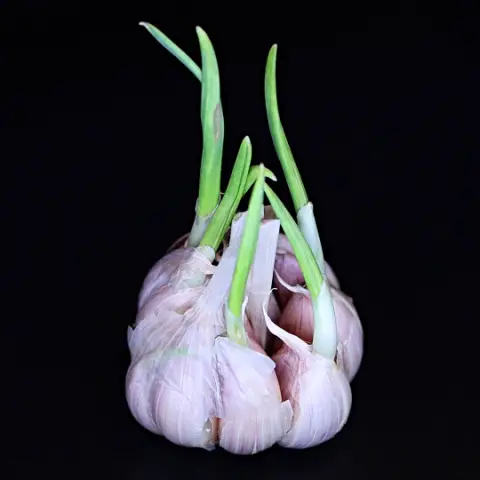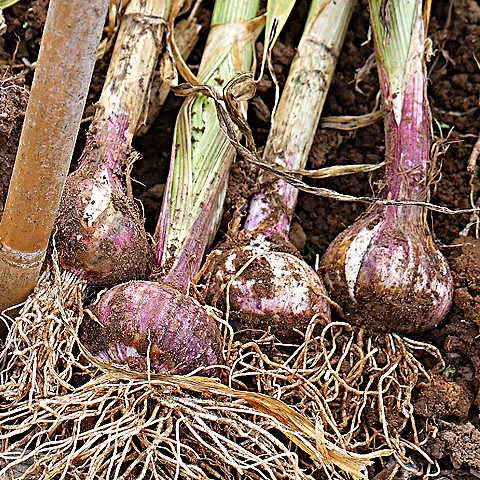15 Best tips for growing garlic
Growing garlic is easy! We love garlic, and here are my tips for growing garlic to get the best harvest and to store it for use throughout the year. You may also want to leave some plants in the garden as garlic makes an excellent companion plant to strawberries and roses, among others.
Health benefits of garlic

Garlic has several potential health benefits. It is suggested to have some effect in reducing blood pressure and cholesterol levels, as well as boosting the immune system. Garlic may also have antimicrobial properties and be effective in fighting off infections. Garlic is also a source of vitamin C, manganese, and other nutrients. But most of all garlic adds a great taste to dishes and enhances the flavor of other ingredients.
Growing garlic – hardneck v softneck
Hardneck and softneck garlic differ in their physical characteristics and growing habits.
Hardneck garlic has a firm stem that grows up from the center of the bulb and produces a flower stalk, called a scape. These are delicious and can be used in recipes like Garlic Scape Pesto. The bulbs of hardneck garlic tend to be larger and stronger in taste than those of softneck garlic. However, hardneck varieties have fewer cloves per bulb and generally, do not store as well as softnecks. Hardneck garlic is usually more cold-tolerant than softneck garlic, and therefore, it is better for growing in cooler climates.

Softneck garlic, on the other hand, has a more pliable stem. The stems are easy to braid. It produces smaller bulbs with more cloves per bulb. The bulbs tend to have a milder flavor than hardneck garlic. Softneck garlic is less cold-tolerant than hardneck garlic. It stores well and is more likely to be found in supermarkets. Softneck garlic is generally better suited to growing in warmer climates.
The best way to plant garlic
- Choose a sunny location for your garlic bed, as garlic needs at least 6 hours of direct sunlight per day to grow well.
- Prepare the soil by mulching with 1-2 inch (3-5 cms) of homemade compost or well-rotted manure to improve the fertility and drainage of the soil. Garlic grows best in well-draining soil with a pH of 6.0 to 7.0.
- For autumn or fall planted garlic – Plant the garlic cloves about one month before the first frost. For spring planted garlic – Plant in early to mid spring, depending on whether your soil is frozen or not. Avoid working frozen soil.
- Separate the cloves from the bulb and plant each clove about 1-2 inches (3-5cms) deep and 6-8 inches (15 – 20 cms) apart, with the pointed end facing up. Only plant firm cloves of garlic, discard any that are soft, discolored or moldy.
- Water the soil well to ensure good contact with the soil.
- Mulch the soil around the garlic plants with homemade compost, straw or leaf mold to help retain moisture and suppress weeds.
- If foraging pests are a nuisance or you find that cats are pooping in your garden, cover with netting to protect against disturbance.
- Water the garlic regularly, keeping the soil evenly moist but not waterlogged.
- If your soil quality is very poor, fertilize the soil around the garlic plants every 4-6 weeks with a balanced liquid fertilizer or compost tea.
- Harvest the garlic bulbs when the leaves begin to yellow and die back in the summer or early fall.

How to harvest growing garlic
As with all allium harvests, do not pull up garlic by the stem. Use a hand fork or trowel under the bulb to lift it gently out of the soil. This reduces the risk of bruising or damaging the stem and lessens the risk of infection, fungus or molds, entering the garlic.
How to cure garlic
After you harvest your growing garlic, it needs to be cured to help it store for longer.

- Do not remove the roots or stems and leaves.
- Place on a rack, roots up if possible.
- Keep out of direct sunlight in a warm, but not hot place.
- Ensure that air is able to flow around the garlic bulbs.
- Once the leaves and stems have become papery, the garlic is likely to be cured enough to move storage.
How to store garlic

- Once the garlic is cured, it can be braided to hang in a cool, airy place.
- Store garlic bulbs in a cool, dry place with good air circulation. This will help them last for several months. We store them in a basket in the cool pantry.
- Peel the garlic cloves and store them in oil in the refrigerator for no more than four days or in the freezer for up to 4 months. Be sure to label them with a ‘dispose by’ date. Do NOT store garlic in oil at room temperature.
- Mix pureed garlic with a little bit of water and then transfer the puree to an ice cube tray to freeze. Once the garlic is frozen, transfer the cubes to a plastic bag and store in the freezer. I double-bag frozen garlic to prevent the garlic flavor contaminating other foods in the freezer. This method will preserve the garlic for several months.
- Dry garlic by slicing the cloves thinly and placing them on a dehydrator tray. Dehydrate the garlic at a low temperature until it is completely dry and crisp. This method will preserve the garlic for several months.
Growing garlic from bulbils
If you have left the scapes to grow on your hardneck garlic, it may produce small bulbils on the top of the stem. These can be used to grow new garlic plants. At the end of the growing season, harvest the bulbils from the stem and separate from each other. Plant the bulbils in a good quality potting compost in a pot or straight into the ground. Don’t forget to label them! It will take at least two years of growth to form a bulb of garlic to harvest.
Perennial garlic
Garlic can be left in the ground year after year to grow as a perennial plant. To harvest from plants grown as perennial, snip the green growth to use like chives or scallions in the kitchen. Or you can lift a clump of garlic, the individual cloves may be smaller than those grown with plenty of space, but there will be plenty of smaller cloves.
- Showstopper flowers in early summer - June 20, 2025
- Best flowering variegated plants - June 13, 2025
- What to Sow in June | Month by month sowing guide - June 6, 2025

Thank you for all that information Liz. I think I will try perennial garlic! I suspect it is a bit late to plant any now but in the Spring….
I hope it’s not too late Sue, I’m putting in a bed full of garlic this morning!
Thank you for the advice on perennialising garlic – I hadn’t come across that before. It’s amazing quite how many of our veg can be perennialised, especially brassicas.